Elmer Keith Museum
Tribute to a Legend
other By: Brian Pearce | February, 26
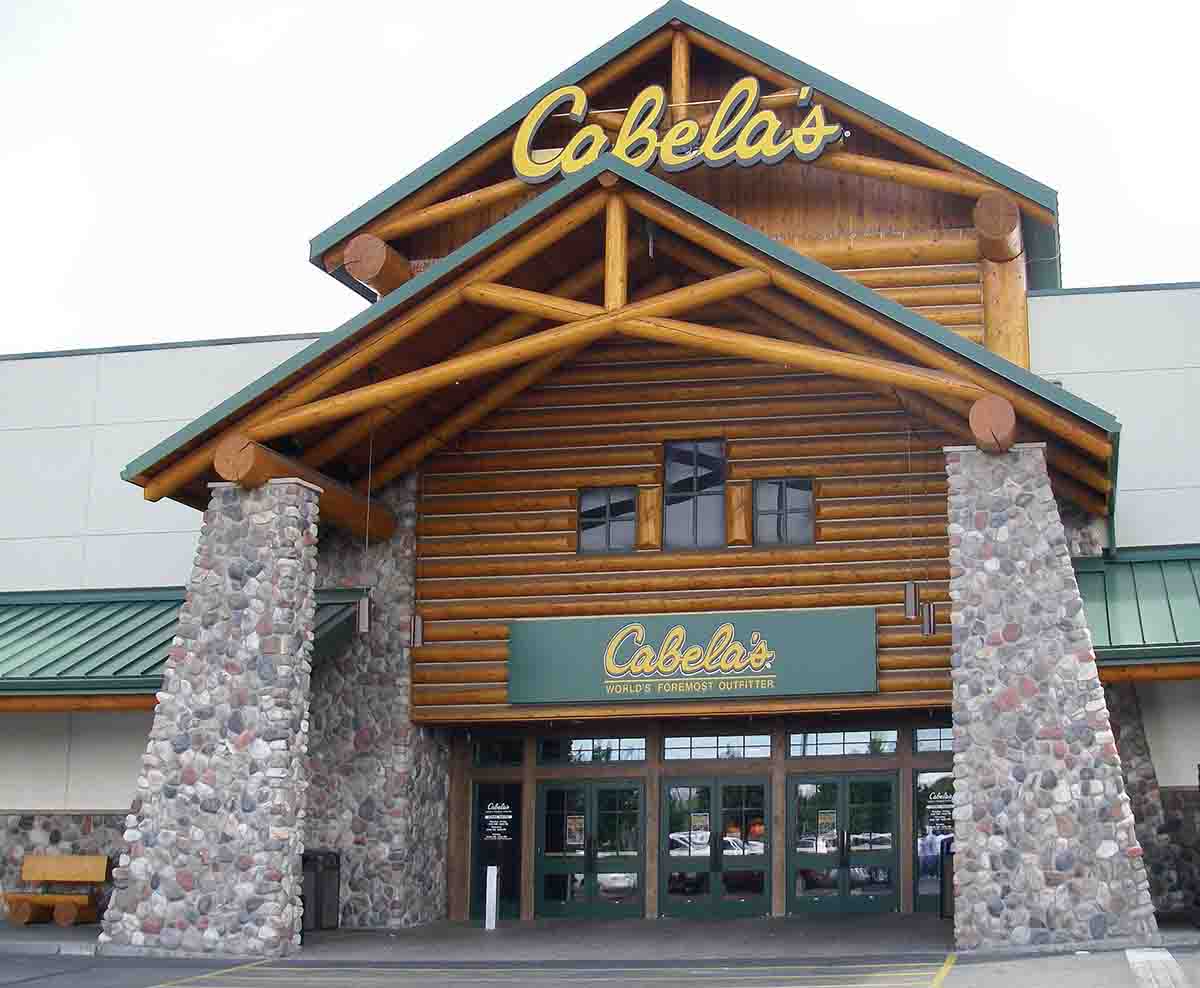
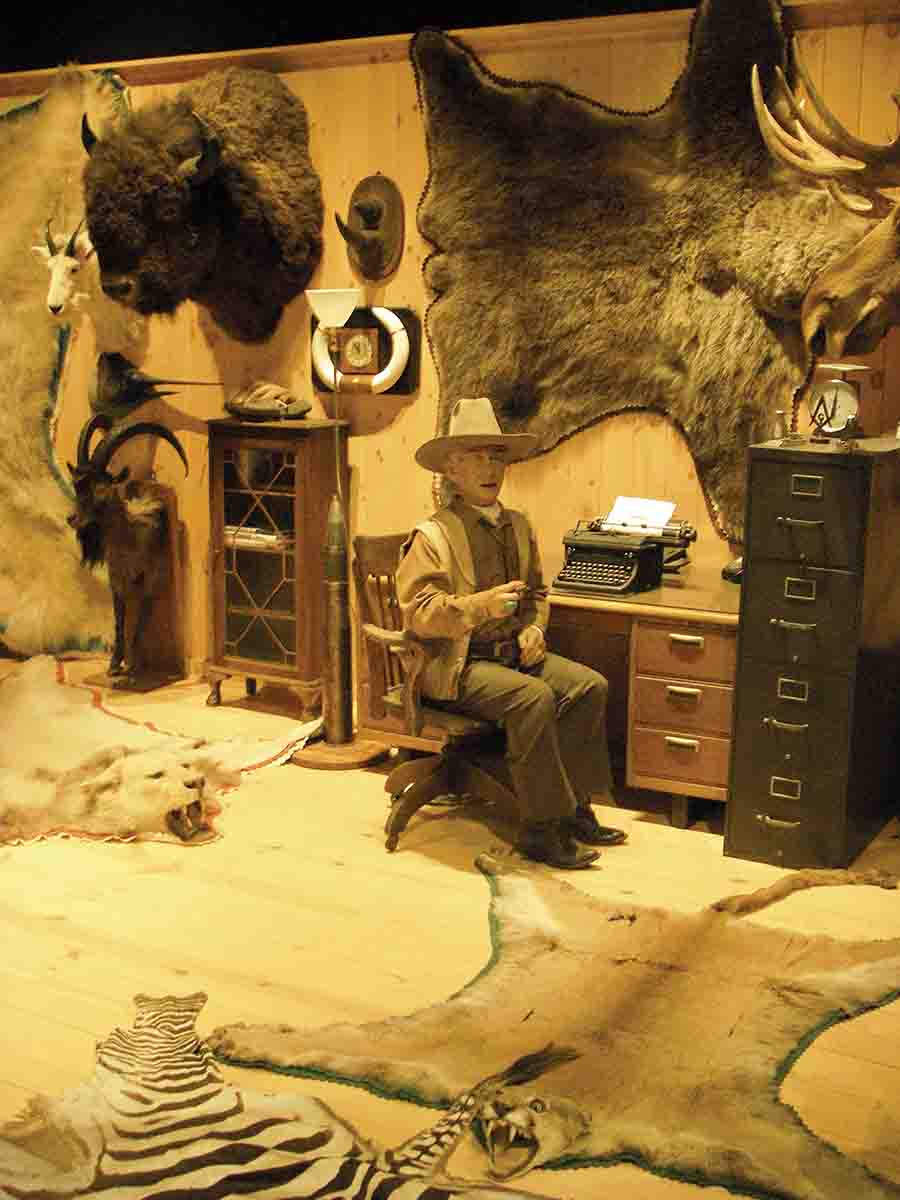
Keith needs no introduction, but to enlighten a new generation of shooters, we will mention that he was a prolific gun writer with a career that spanned over half a
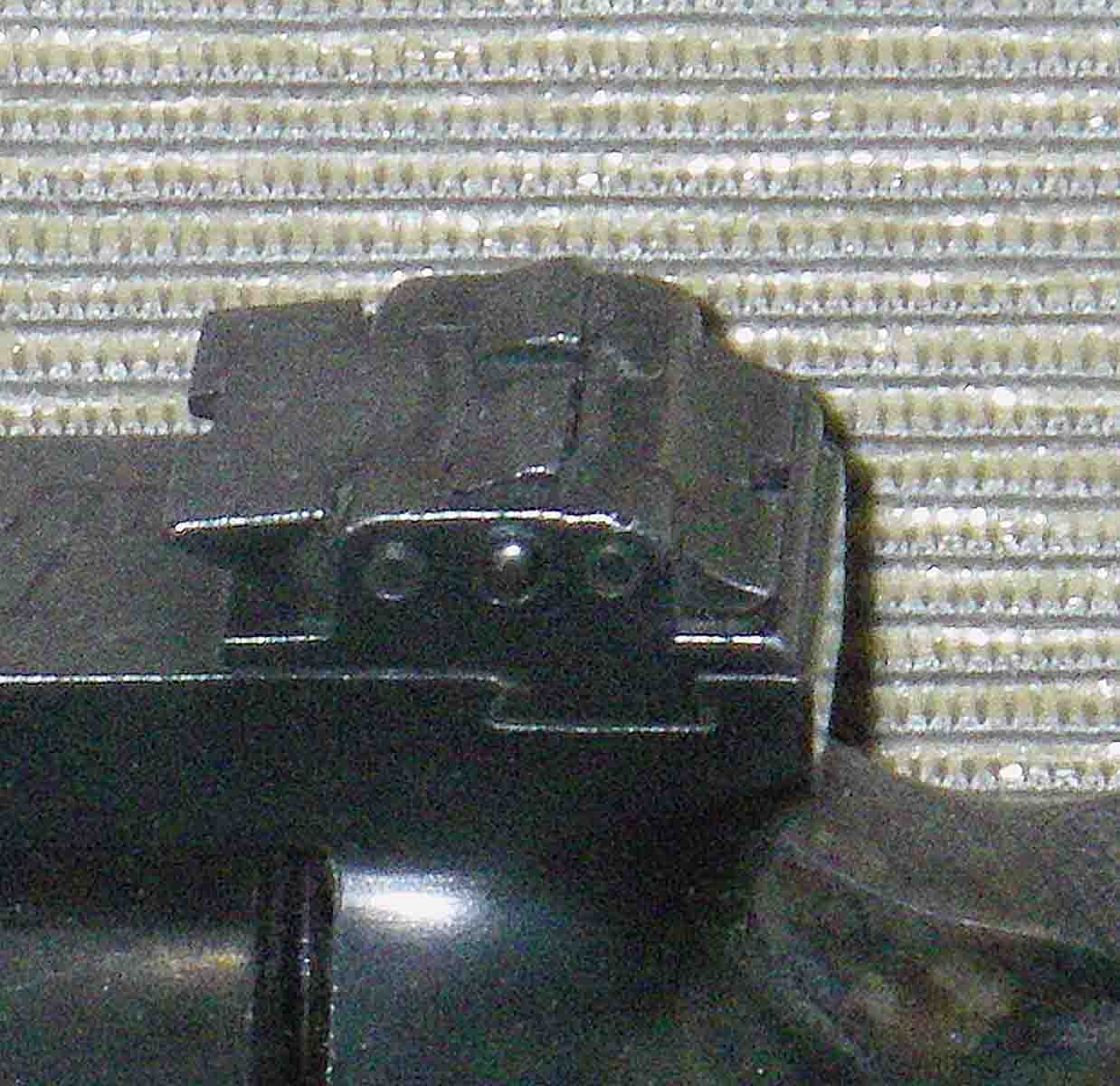
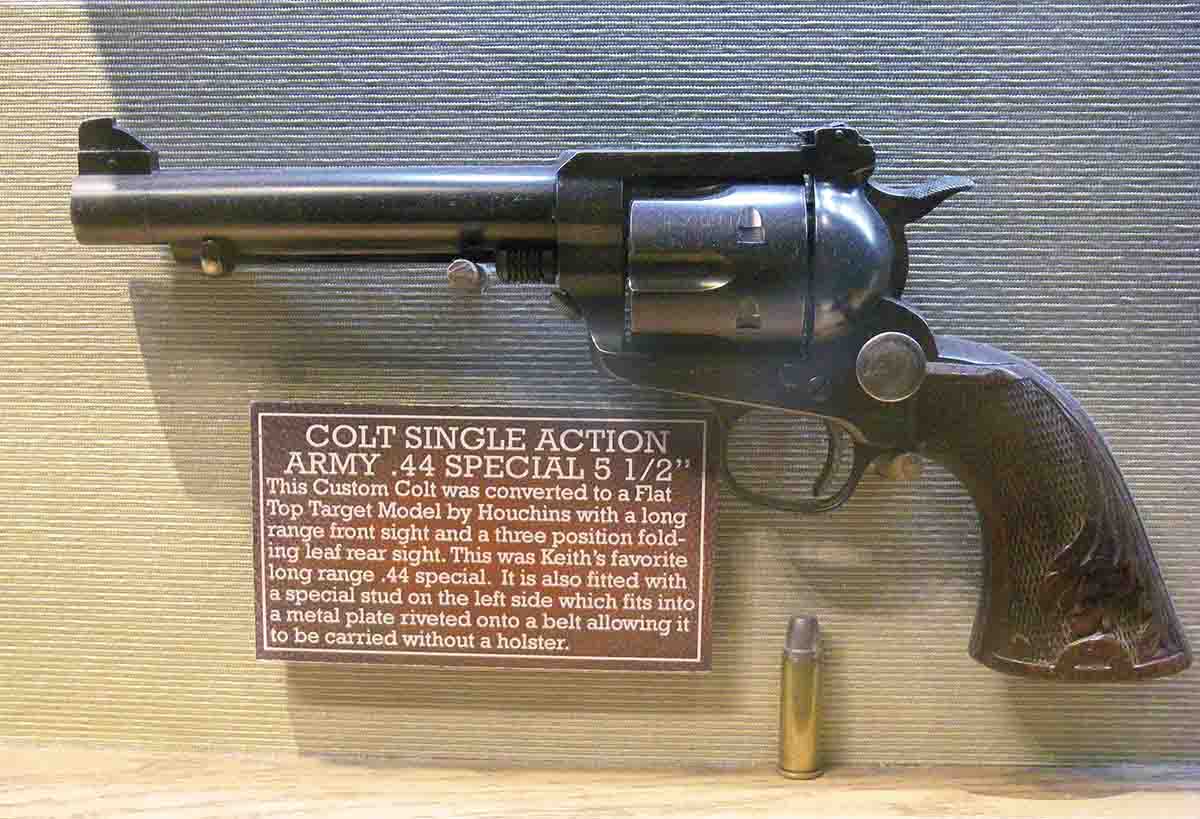
The Cabela’s display includes many of Keith’s record book mounts, mostly from North America and Africa. There is an animated life-size likeness of Elmer, sitting at his desk with hat in place, telling stories taken from his last book, Hell, I Was There (a title he despised). Also displayed are nearly 60 firearms, including a variety of rifles, shotguns, revolvers and pistols.
The Colt Single Actions
In addition to Civil War cap-and-ball percussion Colt revolvers – including an 1851 Navy, 1860 Army, 2nd Dragoon and 1848 Pocket, some of which saw considerable action – there are notable Colt Single Action Army revolvers displayed. During the 1920s, when Keith first “discovered” the virtues of the .44 Special and the potential power it offered if handloaded (which ultimately led to the development of the .44 Magnum), he began acquiring Colt Single Action revolvers. With the aid of several notable craftsmen of the period, they were turned into beautiful custom revolvers.
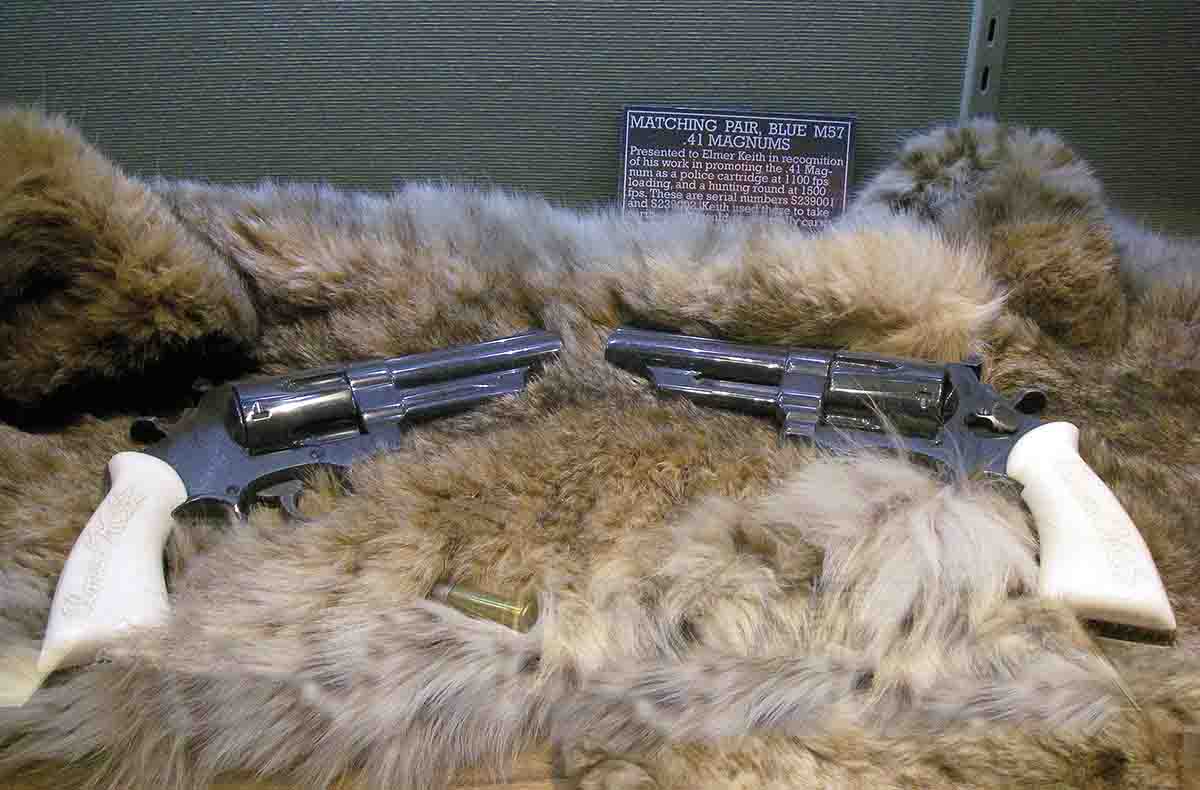
The Keith No. 5 SA Colt revolver has been discussed in previous editions of Handloader, so I’ll be brief in its history and features. Starting with a pre-1896 (sometimes called black-powder) frame, it was welded into a flattop, a windage adjustable rear sight installed and a Colt New Service Target front sight fitted in reverse that allowed adjustment for elevation via a screw. A Colt Bisley backstrap was fitted to the SAA trigger guard and carefully shaped to Keith’s specifications. The hammer was likewise taken from a Bisley model, to achieve a lower profile and wide hammer spur, and the trigger featured a wider than standard profile. A special hourglass profiled base pin head was crafted to allow an easy grasp and removal and was held positively in place by a unique Sedgley latch.
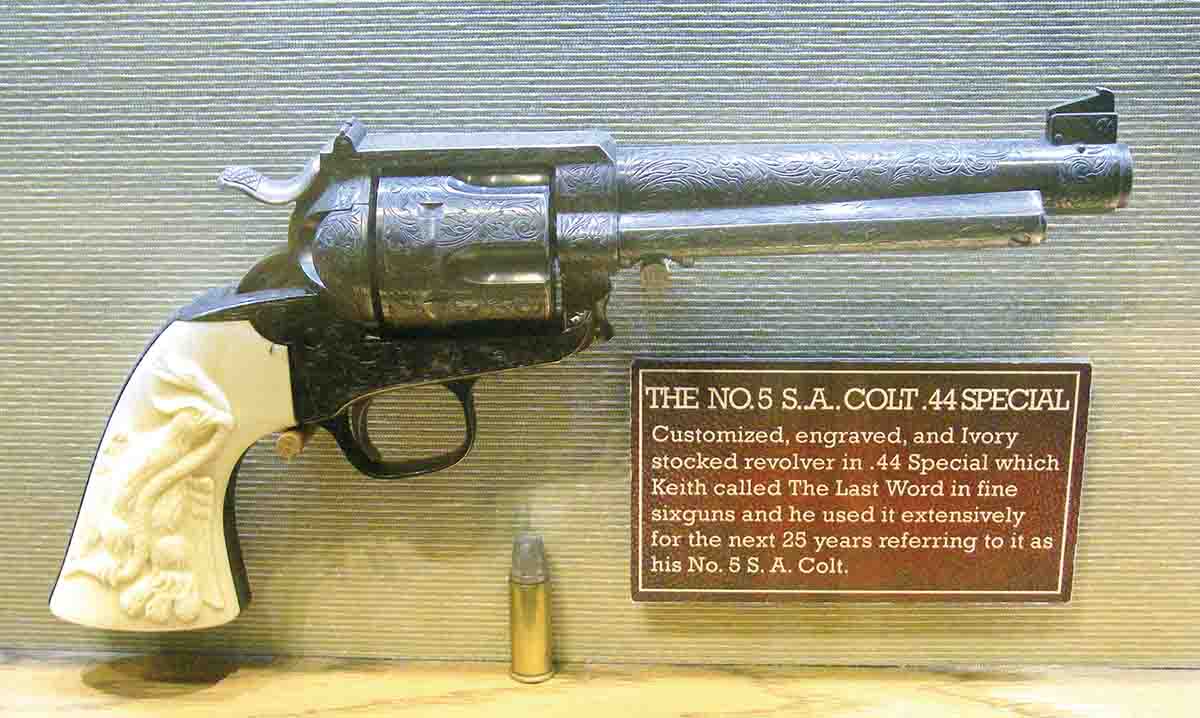
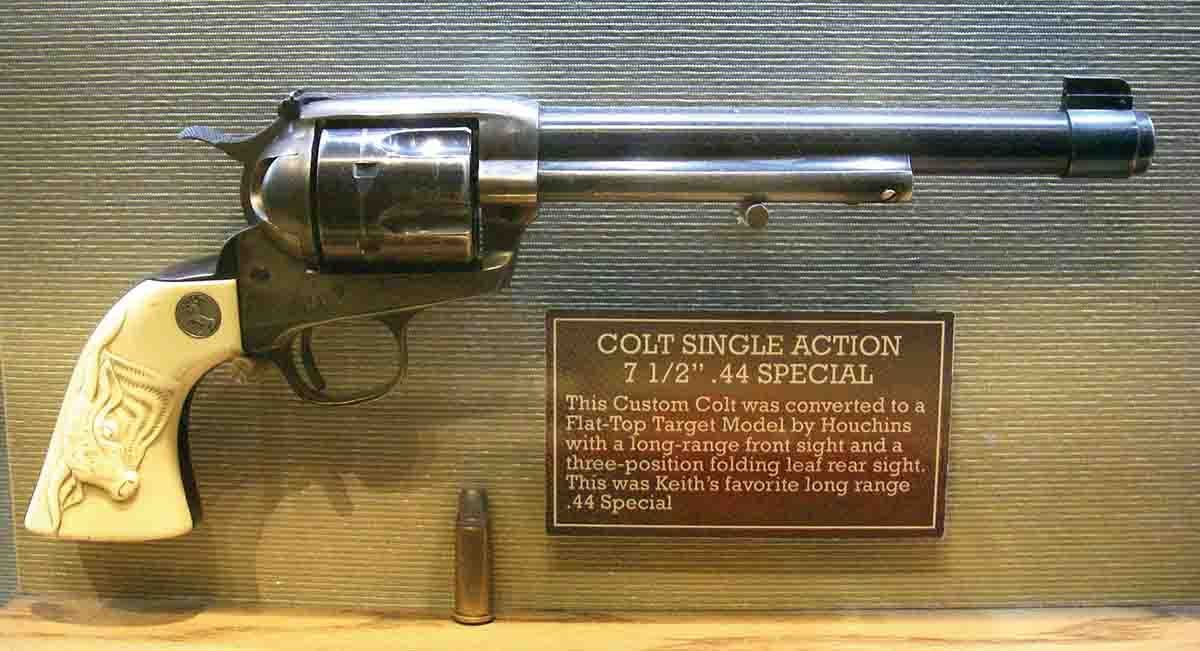
The above No. 5 SA Colt was used heavily by Keith during his years as a guide and outfitter in Idaho’s rugged Salmon River country, so heavily in fact that it was reblued three times dur- ing the years from 1928 through 1956.
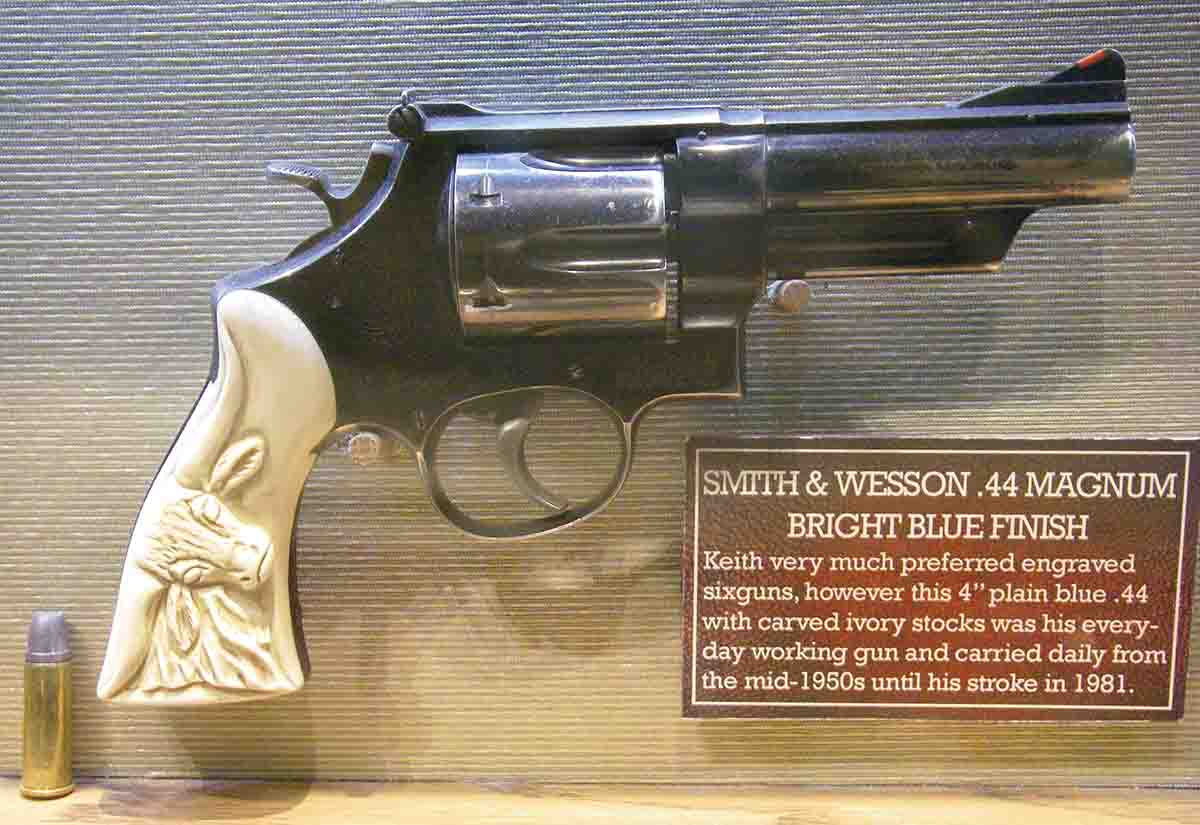
Another significant Colt Single Action Army .44 Special revolver was probably manufactured in 1917. It features a 71⁄2-inch barrel, factory carved ivory stocks and a King Gun Sight Company short action (which shortens the hammer pull and reduces lock time). Additionally the rear sight is a prewar Smith & Wesson (probably taken
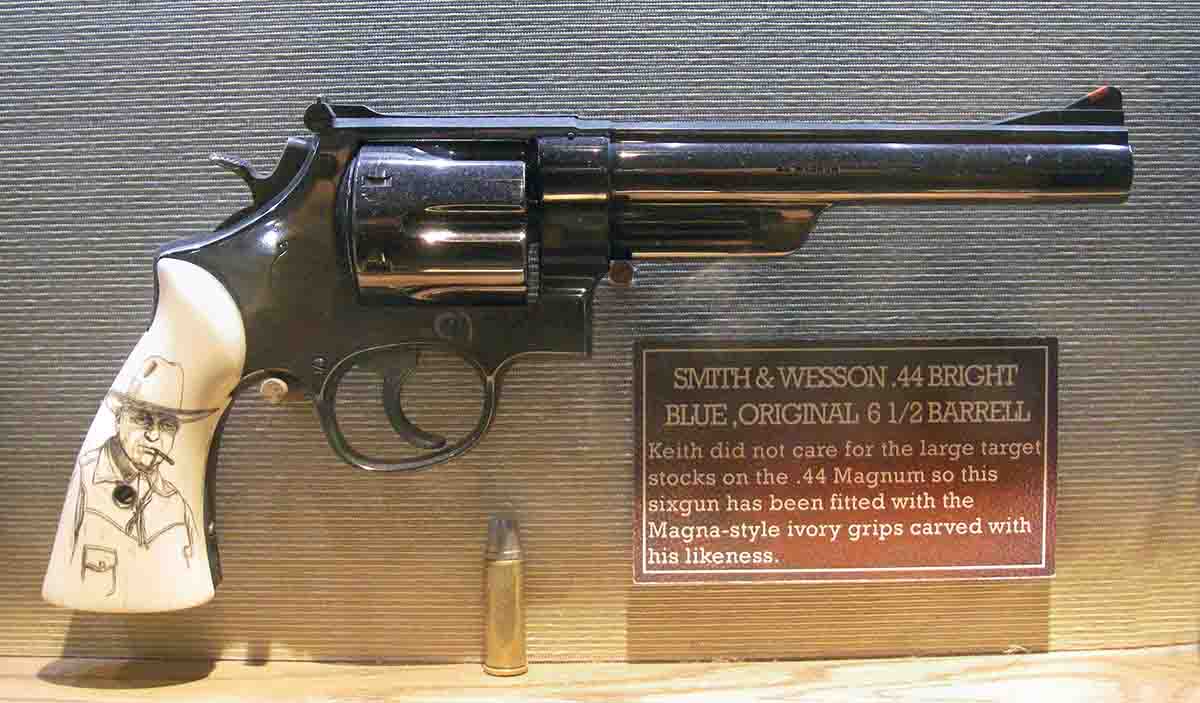
There has been precious little information published regard- ing the history of the next Colt Single Action, and even fewer know its history. It was probably produced in 1889 or 1890. In 1926 Harold Croft of Pennsylvania took Keith to task regarding his comments on long-range sixgunning and said he (as well as many others in prominent pistol clubs) did not believe it was possible. Keith responded by inviting Croft to his ranch located on the sage- and pine-covered Lookout Mountain above the dusty frontier town of Durkee, Oregon. Upon his arrival, Keith demonstrated 700-yard sixgunning across his dry ground hay field on a 4-foot square of boards nailed together. In short Croft ate crow as Keith pounded the target with a variety of sixguns, even one with a 2-inch barrel. Thus began the friendship, and the two experimented to improve bullets for hunting and accuracy, which ultimately lead to “Keith” designs.
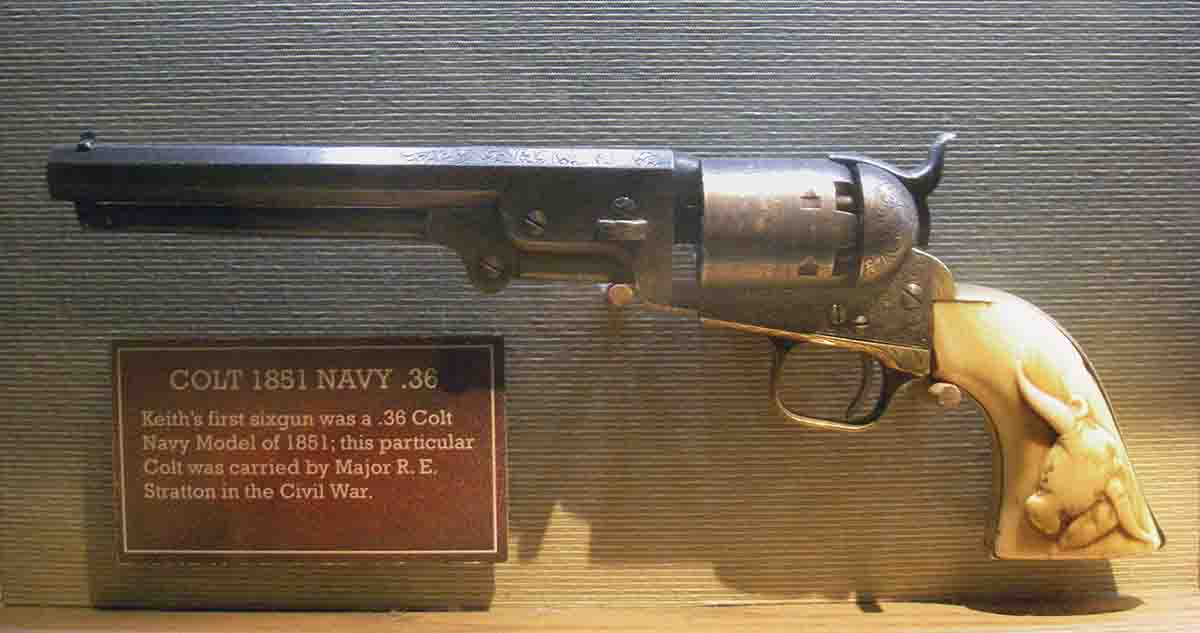

Elmer began acquiring additional Colt single actions to convert to .44 Special (and custom .45 Colts) through gunsmith friends of Croft. Upon Croft returning to Philadelphia, he purchased a Colt Single Action Army revolver from a pawnshop for $5 and shipped it to Keith, which according to Elmer was a “rusty wreck.”
As Keith began sanding off the rust, to prepare it to receive a new barrel, cylinder and custom sights, engraved deeply on the backstrap was the name “Teddy Roosevelt” with “North Dakota” on the bottom of the grip frame. The engraving was left on and the project continued. The gun ultimately became a .44 Special with a 51⁄2-inch barrel (and incidentally was originally a .45, as it is so inscribed on the front bow of the trigger guard). It is fitted with beautifully carved rosewood one-piece stocks, the hammer spur is wide and lowered. Most significant, however, is the flattop frame fitted with a dovetailed three-leaf folding rear sight with the primary blade sighted at 50 yards, the rear leaf at 100 and the front leaf at 200 yards. The left side of the frame is hand engraved “AUG 23 1928” and the top of the frame is marked “KEITH LONG RANGE COLT.”
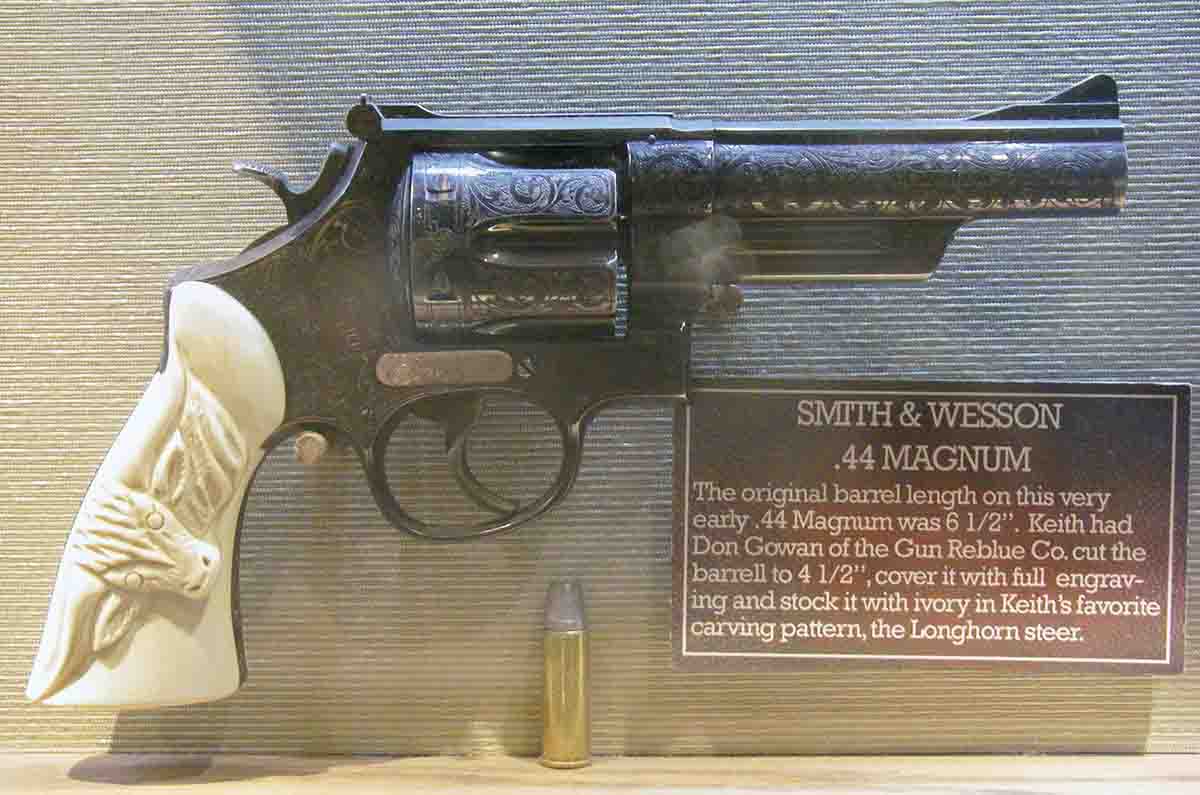
As a side note, in the accompanying photos of this Roosevelt/ Keith revolver, a large stud can be seen projecting from the hammer screw in the frame that was designed to latch onto a slotted plate on the gun belt and could thus be carried without a holster. Keith did not use this gun in that manner, but had taken the special stud from a Colt SAA .45 with a 43⁄4-inch barrel that he owned. The handgun was used primarily as a display item.
Smith & Wesson Sixguns
Keith played a vital role in getting Smith & Wesson and Remington to work together to develop the .44 Magnum. In January 1956, Smith & Wesson shipped revolver S147220 to
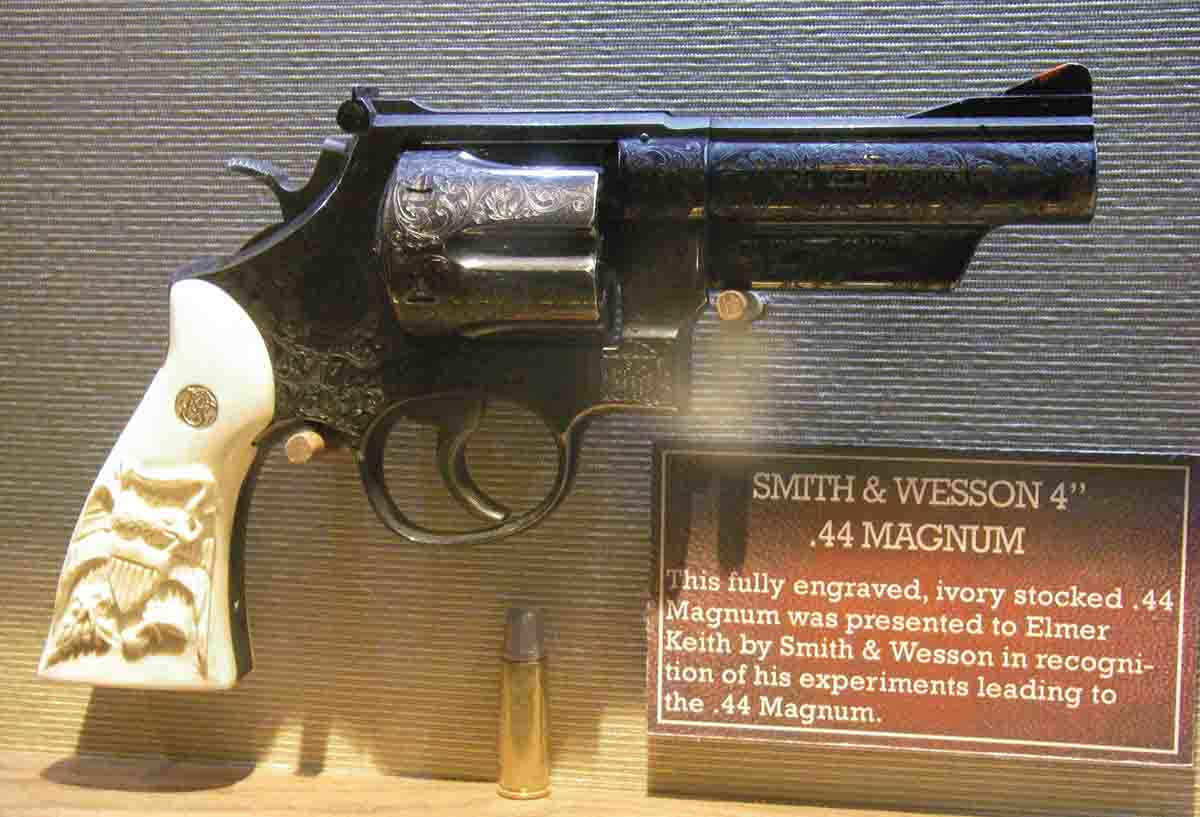
As Keith students know, he favored a .44 Magnum with a 4-inch barrel as his everyday “working” gun, and the museum includes the gun he most often carried the last 25 years of his life. It is plain, without engraving, but has enough blue wear to show character and is fitted with carved ivory stocks of Magna configuration. The signature “Elmer Keith” is engraved on the side plate. Collectors may want to know that it is a “four screw” pre-Model 29.
Two “five screw” pre-Model 29s are also displayed that are heavily engraved and fitted with 4- and 41⁄2-inch barrels, respectively, and carved ivory stocks. The former was presented to Keith for his experiments with the .44 Special and encouragement to Smith & Wesson to develop the .44 Magnum. It is doubtful Keith used either of these guns to any important degree. They were primarily for special occasions. There is also a “plain” pre-Model 29 with the rare 5-inch barrel and a pair of Model 57 .41 Magnums that are reported to be the first two manufactured. There is a Model 1917 .45 ACP engraved by Tom Moro, which is a gun Keith owned and used for more than half a century.
Miscellaneous Handguns
There is a custom Colt Model 1911 .45 ACP from World War I era, fitted with ivory stocks and custom sights, that was carried by Capt. Strong during that war and saw extensive action in the trenches. There are a number of Ruger single actions, naturally in .41 and .44 Magnums that were presented to Keith by Bill Ruger.
Unfortunately there are several significant sixguns that are not displayed at the Cabela’s Keith Museum, but perhaps at a later date they may “appear.” For instance Keith owned an extremely rare Colt Single Action Army Target “Flattop” .44 Special fitted with a 71⁄2-inch barrel. Another Colt Single Action Army featured a 43⁄4-inch barrel, was chambered in .45 Colt and was built on an early black-powder frame. It was fitted with a Smith & Wesson adjustable rear sight and in unusual fashion (at least for a 43⁄4-inch barrel), there was a barrel band and Patridge-style front sight. To dress it up, it was fitted with one-piece ivory stocks that were scrimshawed with a compass (to signify its accuracy). Keith commented that this gun was unusually accurate to one-half mile.
In 1935 Keith reviewed a new gun and cartridge in The American Rifleman magazine known as the Smith & Wesson Magnum (Registered) .357 Magnum with number 0139. Originally it was fitted with an 83⁄4-inch barrel, but Keith returned it to the factory and had it cut to 61⁄2 inches, then put it to work becoming a favorite pest and jackrabbit gun, but it was also known to take javelina (in Arizona) and mule deer.
Additional guns not displayed include Keith’s fine Smith & Wesson Model 1950 Target .44 Special with a 4-inch barrel, which was later engraved and fitted with carved ivory stocks by the Gun Reblue Company. Perhaps Keith’s old Smith & Wesson .38/44 Outdoorsman or New Century (aka Triple Lock) .44 Special that he obtained from legendary speed shooter Ed McGivern might make the display at a later date.
In 1984/85 there was an attempt to build an Elmer Keith Museum, but funds raised were insufficient to break ground. I offer my sincere appreciation to Cabela’s for its support of the long overdue tribute to a man who brought so much to the gun and hunting industry.

